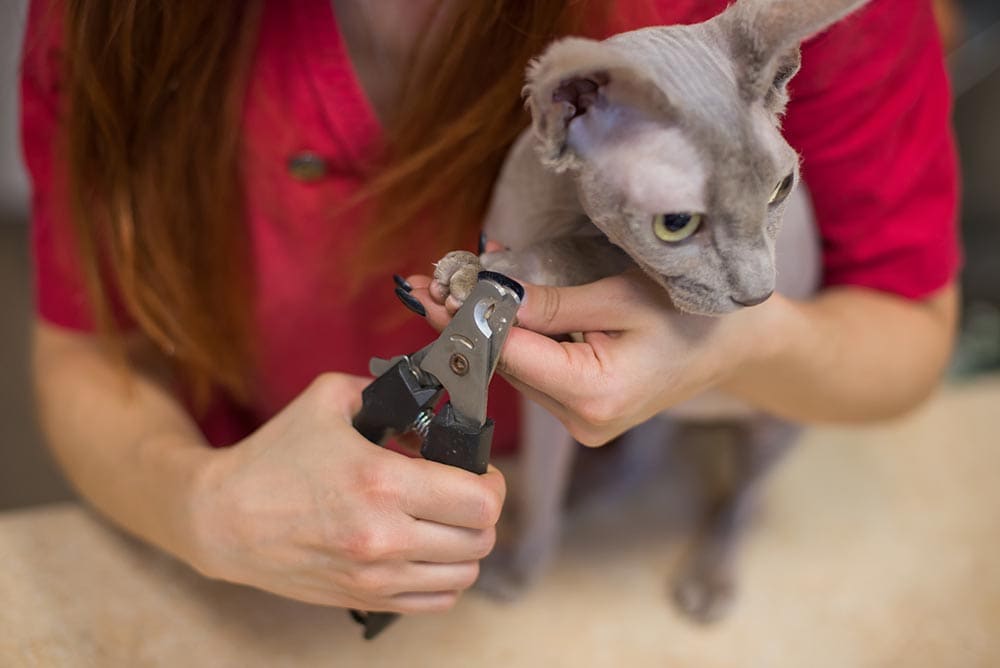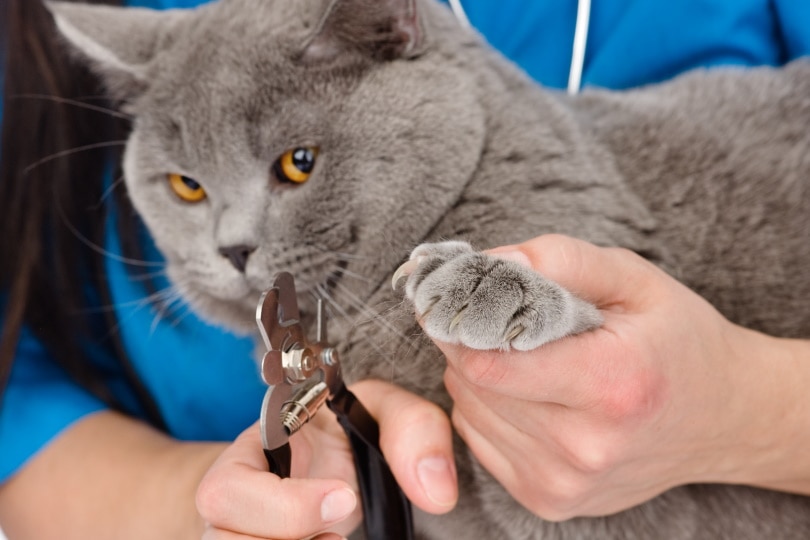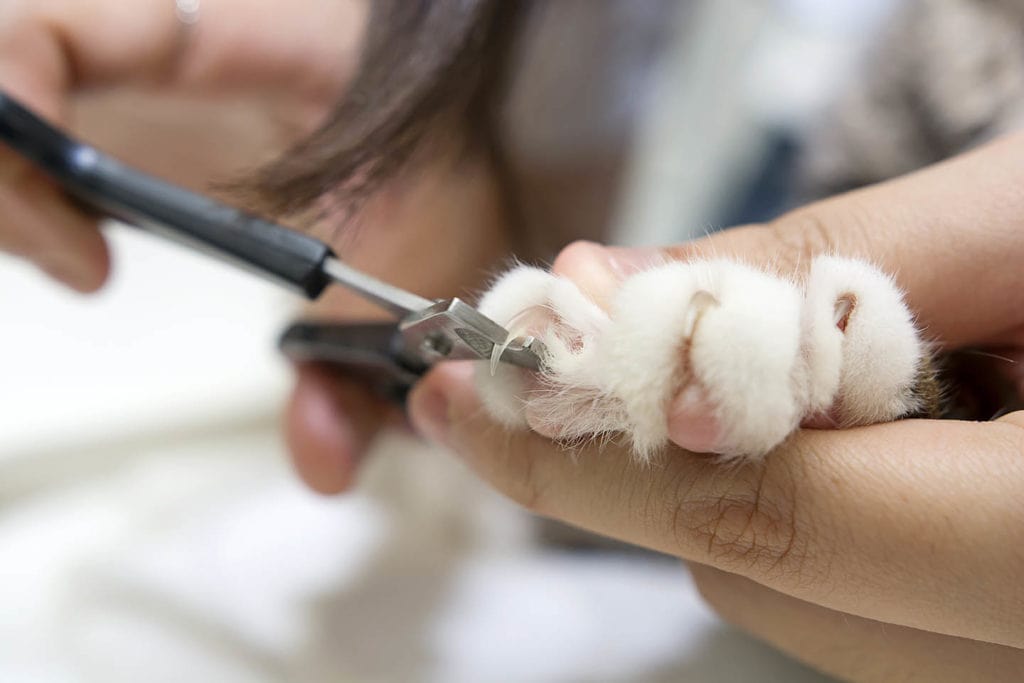
Whether your cat’s long nails are taking a toll on your skin and furniture, or they are finding themselves becoming stuck in your carpet, trimming them can be an essential part of their grooming routine. If you’re lucky, your cat tolerates nail trimming with minimal fuss. If not, you’re probably looking for tips and tricks to get your cat’s nails shorter with less stress and no blood loss.
In this article, we’ll give you step-by-step guidance on how to trim a cat’s nails, even if they aren’t exactly keen on the idea. If your cat turns tail at the sight of nail trimmers and you’re ready to buy shares in Band-Aids, put the nail clippers down for a few minutes and read this guide first.

Before You Begin
The very first step in stress-free nail clipping begins at kittenhood. If you have a young cat (or even a new, not so young cat), the first place to start is getting them used to having their feet, toes, and claws handled. If you can get them to accept foot fondling without any resistance, you’ve won the first battle.
Before you trim your cat’s nails, it’s crucial to ensure you and your pet are in the right mindset for the process. Don’t try to trim your cat’s nails if you’re stressed, in a hurry, angry, tired, or hungry. Your cat will sense your mood, and you won’t have the patience to accomplish this task.
For the best results, approach your cat when they’re relaxed, such as after a meal. Keep other pets and kids out of the room to help your cat feel safer.
Here are the supplies you’ll need to trim your cat’s nails:

The 7 Steps on How to Trim the Nails of An Unco-operative Cat
1. Get Your Cat Used to Having Their Feet Touched
As we mentioned earlier, before you break out the nail trimmers, get your cat used to touching their feet. Have your cat sit in your lap and pet their head, neck, and shoulders, slowly moving down their legs to their paws.
Massage your cat’s paws and toes gently, reassuring them and feeding treats to help them form positive associations with having their feet touched. Spend several days, or longer, desensitizing your cat until they remain calm when you’re handling their paws.
2. Choose the Right Nail Trimmers

To make nail trimming easier, you need the right equipment. The scissor-style nail trimmers are a popular choice. Smaller nail trimmers are better for cats so you can get closer to the nail without risking pinching the toe. Make sure they are in good condition and move smoothly.
3. Get Your Cat Used to the Nail Trimmers
Along with getting your cat used to having their paws handled, you’ll want to familiarize them with the sight and sound of the nail trimmers. Show your cat the nail trimmers as you hold them and pet them.
Open and close the trimmers so your cat gets used to the snap. You might even want to touch your cat’s paws with the closed trimmers. Work slowly and offer your cat treats and reassurance to keep them calm.
4. Keep Your Cat Under Control

There’s no one-size-fits-all approach to holding or restraining your cat for a nail trim. Some cats do better with a “less is more” method, such as being held in a lap. Others may feel safer or more comfortable wrapped in a towel or blanket.
If you’re trimming your cat’s nails on your own, try setting them on a counter or table and tucking their body into the crook of your elbow to keep them from backing away as you work. If you have someone helping you, they can either hold the cat as you trim or distract the kitty by petting them as you cut the nails.
Be aware that some cats will become more worked up the tighter you hold them. If your cat becomes very stressed or angry, it is better to disengage and let them calm down, and go back to stage 1.
5. Trim Carefully
If your cat already hates nail trims, cutting their claws too short and causing pain won’t help the situation. Don’t get too ambitious as you trim, especially if you’re early in training your cat to accept the process. Gently press on the cat’s paw to extend their nails and trim off just the sharp tip.
If your cat is tolerating the process, you can carefully cut off just a little more at a time if you can easily see the quick or pink part of the nail. Position the nail trimmers so they cut the nail vertically, not horizontally. If you cut it too short and make the nail bleed, apply styptic powder, flour, or cornstarch to help it clot.
6. Take What You Can Get

If your cat is just learning to accept nail trims, don’t push too far too fast. You may only be able to trim one nail the first time you do it, and that’s okay. Long-term, you’ll have more success if you take your time at the beginning and build your cat’s tolerance carefully.
Let your cat dictate how much you trim each time. You want to end the session when the cat is still calm rather than stressed and fighting. Otherwise, you’ll accidentally teach them that resisting is the way to escape nail trims.
7. Reward Generously
Treats are your best friend as you train your cat to accept nail trims. Reward your cat each step of the way to help them learn to associate nail trims with yummy treats instead of stress and anxiety. Provide praise and reward your cat when you finish the trimming process.

How Often Should You Trim Your Cat’s Nails?
Most indoor cats should have their nails trimmed every 2–4 weeks, depending on how fast they grow. Cats who spend time outside and rely on their nails to help them climb, hunt, and defend themselves from predators usually don’t need nail trimming unless their claws grow particularly long. They generally keep their nails worn down naturally.

Conclusion
For the best results, start teaching your cat to accept nail trimmings when they’re a kitten. However, if you adopt an older cat, there’s a good chance they won’t let you trim their nails, and you may need to rely on the steps we taught you in this article. If you’re struggling to trim your cat’s nails at home, especially if they’re showing aggression, don’t be afraid to ask your vet for help. You can also take your kitty to a professional groomer for nail trimming.
Featured Image Credit: Reshetnikov_art, Shutterstock


